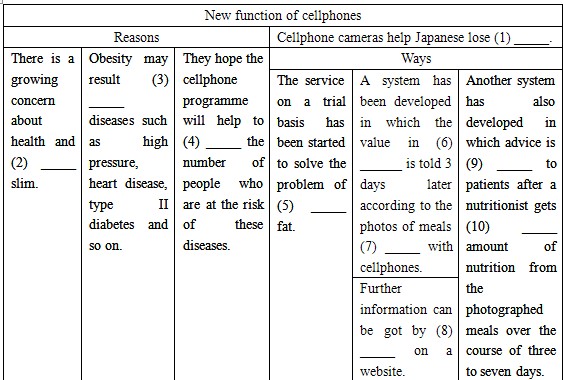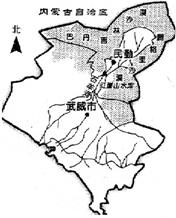阅读理解。
请认真阅读下列短文,并根据所读内容在文章后表格中的空格里填入最恰当的单词。注意:每空
格1个单词。
Wondering how many calories the banana cream pie on your plate has? Some Japanese have a novel way
to find out: Photograph it with a cellphone and send the image to an expert. With cellphones becoming
common in Japan and rising concern over expanding waistlines, health-care providers will allow the
calorie-conscious people to send photos of their meals to nutritionists (营养学家) for advice.
Public health insurance offices in Osaka in Western Japan have launched the service on a trial basis. About
100 cardiac (心脏病的) patients signed up in the first year, followed by diabetes and obesity patients in the
second."Japanese have been getting fatter, especially men in their 20s and 30s. There is concern over what they
learned about nutrition when they were younger," the Osaka official, Satomi Onishi, said."We're hoping that this
program can help us deal with the problem."
Osaka is using a system developed by Asahi Kasei Corp. The system is operating among about 150
health-care providers and local governments around the country Nutritionists can work with photos from one
day's meals to several weeks' worth. Results come back in three days. People can also log on a website to get
further information.
Dr Yutaka Kimura has developed a similar system at Kansai Medical University's Hirakata Hospital, also in
Osaka. Five patients have taken part in the programme, which costs $37 to join and $21 per month. Patients
photograph meals over the course of three to seven days, and a nutritionist e-mails advice to them. "Patients
used to fill in meal logs, but people tend to forget things or underestimate (低估) their portions (份)," Kimura
said. "Photographing meals and e-mailing them can be easier and get more accurate results."
As Japanese have turned to bigger portions and more meat and fried foods, obesity and related illnesses
such as high blood pressure have become a rising concern. The Health Ministry estimated last year that more
than half of Japanese men and about one in five women between 40 and 70 years old were at the increased
risk of heart disease, type II diabetes and other diseases because of obesity. With the Health Ministry hoping
to see a 25% reduction in the number of people at the risk of these diseases by 2015, Osaka officials hope the
cellphone program will help.

1. weight 2. keeping 3. in 4. reduce 5. being
6. nutrition 7. taken 8. logging 9. e-mailed 10. accurate

